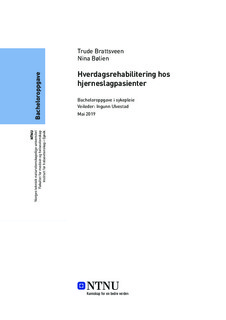| dc.contributor.advisor | Ulvestad, Ingunn | |
| dc.contributor.author | Brattsveen, Trude | |
| dc.contributor.author | Bølien, Nina | |
| dc.date.accessioned | 2019-09-06T14:04:00Z | |
| dc.date.available | 2019-09-06T14:04:00Z | |
| dc.date.issued | 2019 | |
| dc.identifier.uri | http://hdl.handle.net/11250/2613326 | |
| dc.description.abstract | Innledning: Demografisk utvikling fører til en økende andel eldre, som gir en skjevfordeling med antall yrkesaktive i samfunnet. Det er behov for å endre fokus fra pleie og omsorg til forebygging og rehabilitering. Hjerneslag rammer omtrent 12 000 personer i Norge årlig, og er den vanligste årsaken til funksjonshemming. Denne pasientgruppen har stort rehabiliteringspotensiale, og hverdagsrehabilitering kan være en hensiktsmessig rehabiliteringsmetode. Intervensjonens hovedfokus er å øke pasientenes selvstendighet, og motvirke ytterligere funksjonsfall.
Hensikt: Å identifisere resultater av hverdagsrehabilitering, og hvordan sykepleier bør arbeide for å hjelpe pasienten å oppnå disse resultatene.
Metode: Litteraturstudie. Strukturerte søk er gjennomført for å finne resultater relatert til problemstillingen. Det ble benyttet ulike databaser, og syv vitenskapelige artikler er inkludert i litteraturstudien.
Resultat: Rehabilitering i pasientens hjem kan blant annet øke pasientenes brukermedvirkning, selvstendighet, fysisk funksjon og ADL-ferdigheter. Pasientene har behov for informasjon og inkludering, samt helhetlige og koordinerte tjenester. Koordinering og kommunikasjon mellom pasienten og det tverrfagelige teamet faller inn under sykepleierens ansvarsområde. Sykepleier har ansvar for vurdering av pasientenes tilstand og aspekter som påvirker pasientens rehabilitering, integrering av pasientens treningsprogram, emosjonell støtte, samt fysisk og teknisk pleie.
Konklusjon: For å fremme gode resultater av hverdagsrehabilitering hos hjerneslagpasienter, bør sykepleieren sørge for god kommunikasjon og koordinering av det tverrfaglige teamet rundt pasienten. Sykepleieren bør ivareta pasientens autonomi, informasjonsbehov og grunnleggende behov. I tillegg bør sykepleier motivere pasienten til endring, benytte empowerment som hjelpemiddel og vise fysisk og psykisk støtte etter pasientens behov. | |
| dc.description.abstract | Introduction: A demographic development leads to an increased proportion of the elderly, which gives a skewed distribution with the number of working people in the society. There is a need to change the focus from care, to prevention and rehabilitation. Stroke affects roughly 12 000 persons in Norway annually, and is the leading cause of disability. This patient group has a big potential for rehabilitation, and home rehabilitation can be an expedient rehabilitation method. The intervention’s main focus is to gain the patient’s independence, and prevent additional loss of function.
Aim: To identify the results of home rehabilitation, and how the nurse should work to achieve these goals.
Method: Literature study. Structural searches have been carried out to find results related to the problem. Various databases were used, and seven scientific articles were included in the study.
Results: Rehabilitation in the patient’s home may increase user involvement, independence, physical function and ADL-functions. The patients need information and inclusion, as well as comprehensive and coordinated services. Coordinating and communication between the patient and the interdisciplinary team falls under the nurse’s area of responsibility. The nurse is responsible for assessing the patient’s condition and aspects that affects the patient’s rehabilitation, integrating of the patient’s rehabilitation program, emotional support, as well as physical and technical care.
Conclusion: To promote good results of the home rehabilitation of stroke patients, the nurse should promote good communication and coordination of the interdisciplinary team around the patients. The nurse should safeguard the patient’s autonomy, information needs and basic needs. In addition, the nurse should motivate the patient to change, use empowerment as a tool and show physical and mental support according to the patient’s needs. | |
| dc.language | nob | |
| dc.publisher | NTNU | |
| dc.title | Hverdagsrehabilitering hos hjerneslagpasienter | |
| dc.type | Bachelor thesis | |
